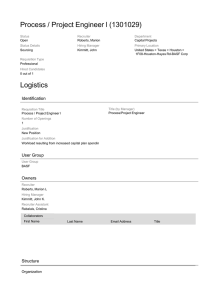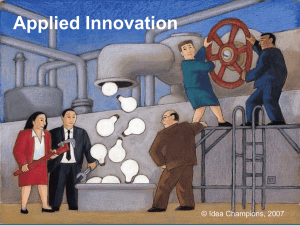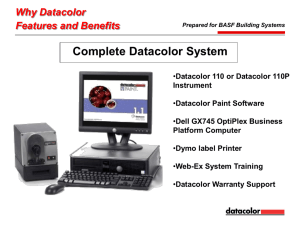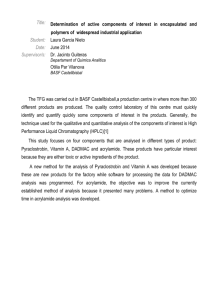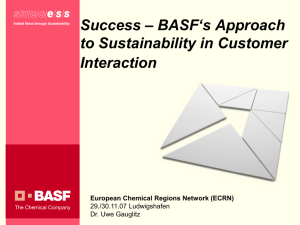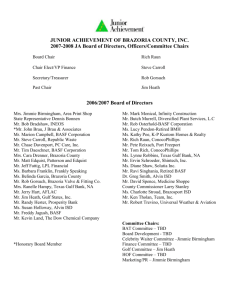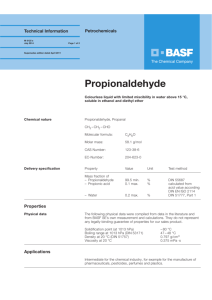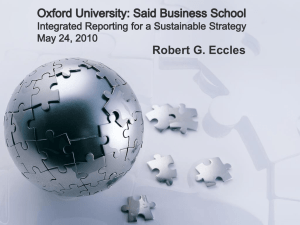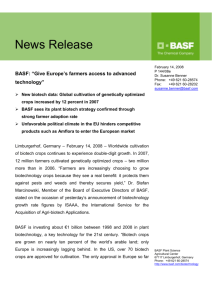Folie 1
advertisement
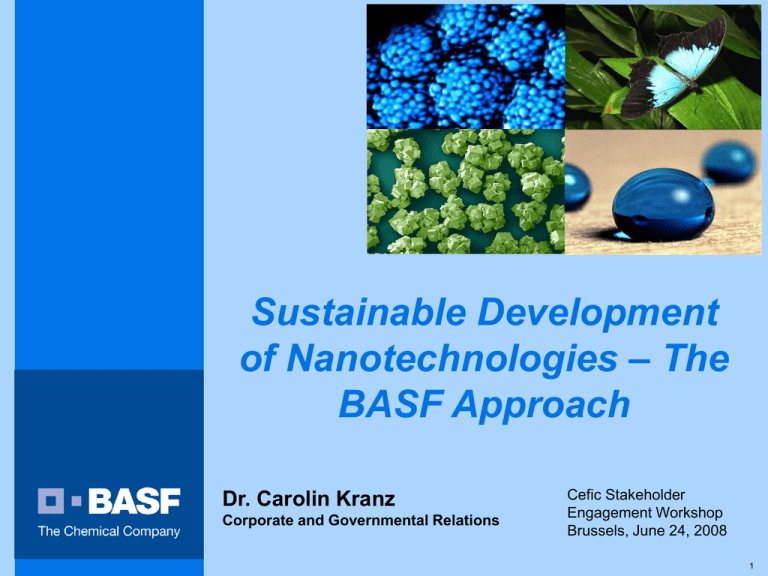
Sustainable Development of Nanotechnologies – The BASF Approach Dr. Carolin Kranz Corporate and Governmental Relations Cefic Stakeholder Engagement Workshop Brussels, June 24, 2008 1 BASF at a Glance BASF – The Chemical Company The world’s leading chemical company Sales 2007: € 57,951 millions Income from operations (EBIT) 2007: € 7,316 millions Employees at year-end 2007: 95,175 Our portfolio ranges from chemicals, plastics, performance products, agricultural products and fine chemicals to crude oil and natural gas 2 Nanotechnolgy: Innovation Driver for BASF 2006 – 2008: About 920 Mio. € research investments in focus areas: Energy management 80 Plant biotechnology 100 Raw material change 400 180 White biotechnology 160 Nanotechnology in Million € Our goal is to provide nano-composites, nano-formulations and nanosystems as solutions for our customers in the automotive, the construction, the electronic, the medical devices, the textile industry and other industries as well as for the energy sector.... 3 Sales Products: Nano Makes the Difference adhesion dirt-resistance eco-efficiency bioavailability self-cleaning sun protection 4 COL.9 – Anti-Aging for Facades due to Nanotechnology COL. 9 = Colour + 10-9 5 What is the Innovation? Paints have at least 3 components: water, pigment and a binder The binder upon drying bonds the paint with the substrate and bonds the pigments together Dispersion paints contain hydrocarbon based organic binders Problem: Surfaces of dispersion paints are not scratch resistant and often tacky, leading to a high dirt pick up. In silicate paints the binder consists of a silicate, which forms a cristalline structure with the substrate Problem: Silicate paints can only be applied to specific substrates and are brittle 6 What is the Innovation? Solution: Using nanocomposites (organic polymer and 10-20 nm silica particles) as paint binder soft polymer matrix hard particles 7 Improved Properties of Paints Based on Nanocomposite Dispersion COL.9 DS 1100 The Innovation for Waterborne Facade Paints with Outstanding Durability Color Retention Exterior paint based on nanocomposites (solvent free) Exterior paint based on standard dispersions Chalking Resistance Dirt Pickup Resistance Crack Resistance 8 Col.9 – Anti-Aging for facades due to nanotechnology http://www.cefic.org/Files/Downloads/col9_e.wmv 9 Nanocomposites –learning from nature Symbiosis of inorganic and organic world on nanometer scale: Nature forms composites based on organic and inorganic material to achieve unique properties only achieved by combination: • hardness • porosity • mechanical properties 10 Responsibility: The BASF Code of Conduct Nanotechnology The BASF Code of Conduct is a voluntary commitment to responsible action based on our Values & Principles: protection of employees, customers and business partners protection of the environment participation in safety research commitment to open communication and dialogue The BASF Code of Conduct was agreed upon by the Board. It describes the framework for our activities and is published on our website at: www.basf.de/dialoguenanotechnology 11 Safety: Each Nanomaterial is different Nanomaterials Nanoparticles e.g. UV absorber in sun screens Nanostructured Surfaces e.g. lotus leaf Nanostructured Materials e.g. mortars and concrete Components e.g. Organic Light Emitting Diodes (OLEDs) 100-200 nm 12 Safety: Focus on free insoluble Nanoparticles and Nanofibres Nanoparticles and Nanofibres Nanoparticles fixed in matrix e.g. Ultradur® High Speed Nanoparticles fixed in formulations Free Nanoparticles Free Nanofibres e.g. Dispersion Col.9 13 Safety COL.9 – Life Cycle Assessment Source: Internet Production of the Col.9 Dispersion at BASF Are BASF employees safe? Manufacturing of the facade paintings at BASF customers Are employees of BASF customers safe? Source: Internet Painting of the facades Are painters safe? Weathering during usages Is the environment safe? 14 Safety COL.9 – Toxicology Beyond compliance with existing law, BASF conducted the following tests with the particles or the Col.9 dispersion: Mutagenicity Skin irritation Acute oral toxicity (rat) Aquatic toxicity (daphnia) Short-term inhalation test* Result: The studies did not show any hazard caused by the nanomaterial used. * Short-term inhalation test developped by BASF to reduce costs and animals 15 Safety COL.9 – Life Cycle Assessment Source: Internet Production of the Col.9 Dispersion at BASF Are BASF employees safe? Manufacturing of the facade paintings at BASF customers Are employees of BASF customers safe? Source: Internet Painting of the facades Are painters safe? Weathering during usages Is the environment safe? 16 Nanoparticle Measurements: Challenge Background Contamination Background Contamination 7000 5000 4000 3000 2000 1000 931 692 521 397 307 241 191 153 124 101 82,8 68,2 56,4 46,8 38,9 32,4 27 22,6 18,9 15,8 13,2 0 11,1 Number of Particles / cm3 6000 Particle Size 17 Nano Particle Concentrations in different environments Closed Rooms (Source: measurement result of BASF) Background burden at BASF Verbund-Site in Lu (Source: measurement result of BASF) At industrial workplaces (Source: measurement result of BASF) At the oven of a bakery (Source: BGIA) At a highly frequented street including street work (Source: measurement result of BASF) In cigarette smoke (Source: measurement result of BASF) During WIG-welding (Source: measurement result of BASF) In diesel exhaust fumes (Source: Grimm Aerosol Technik) 103 to 104 P/cm3 up to 104 P/cm3 up to 105 P/cm3 up to 640,000 P/cm3 up to 106 P/cm3 up to 106 P/cm3 up to 107 P/cm3 up to 1010 P/cm3 18 Abrasion trials: Development of an experimental setting to measure the release of nanoparticles from a solid matrix 1m3-clean room chamber and SMPS-measuring equipment Abrasion equipment in the open clean room chamber Goal: To reduce background contamination of natural and anthropogenic nanoparticles to a minimum 19 Abrasion Trials COL.9 Background Contamination in the Clean Room Chamber Comparison of number of particles between background contamination and dispersion HA 47/5 during rubbing 2000 2000 1800 1800 1600 Hintergrundbelastung P ges= 3744 P/cm³ Number of Particles / cm³ 1200 1000 800 1400 1000 800 600 600 400 400 200 200 0 HA 47/5 P ges.=2529 P/cm³ 1200 52 1 69 2, 1 93 0, 5 24 1 30 7, 4 39 7, 4 82 ,8 10 1, 1 12 4, 1 15 3, 4 19 1, 3 68 ,2 56 ,4 46 ,8 38 ,9 27 32 ,4 22 ,6 18 ,9 15 ,8 13 ,2 52 1 69 2, 1 93 0, 5 24 1 30 7, 4 39 7, 4 82 ,8 10 1, 1 12 4, 1 15 3, 4 19 1, 3 68 ,2 56 ,4 46 ,8 38 ,9 27 32 ,4 22 ,6 18 ,9 15 ,8 13 ,2 0 Particle Size in nm 11 ,1 Number of Particles / cm³ 1400 11 ,1 Background Contamination P ges.=3744 P/cm³ 1600 Particle Size in nm Comparison total number of Particles in P/cm³ of different Dispersion 4000 Hintergrundbelastung HA 47/5 3500 Akzo Farbe R 684 RV 436 3000 HA 50/13 Number of Particles in / cm³ Result: Abrasion trials did not show any additional release of nanoparticles into the environment! HA 51/1 2500 2000 1500 1000 500 0 1 20 Safety COL.9 Source: Internet Production of the Col.9 Dispersion at BASF Are BASF employees safe? Manufacturing of the facade paintings at BASF customers Are employees of BASF customers safe? Source: Internet Painting of the facades Are painters safe? Weathering during usages Is the environment safe? 21 Safety Research to further improve the safety of our products (1) “NanoTox” and method development “Aerosol Characterization” NanoCare HESI / ILSI Nanomaterials Program ACC Nanomaterials Voluntary Program NanoSafe 2 CellNanoTox 22 Safety Research to further improve the safety of our products (2) www. basf.de/dialogue-nanotechnology/safety_research 23 Umsetzung Verhaltenskodex: Transparenz und Dialog 2006 First MultiStakeholder Event in Berlin jointly with Siemens 2007 Booth and Panel Discussion at the Evangelischen Kirchentag in Cologne 2008 Launch of the BASF Dialog Forum with NGOs, consumer groups and churches 2009 Employee dialogue together with the BASF Workers Council and the Chemical Industrial Union 24 Take Home Messages For BASF Nanotechnology is key technology for innovation and growth Besides the large potential for the future, BASF has a few nanomaterials on the market. One example is our binder COL. 9 The framework for our responsible development of nanotechnologies forms our BASF Code of Conduct Nanotechnology Not every nanomaterial raises new risk questions- safety discussions should be focused on free insoluble nanoparticles and nanofibres Beyond compliance with existing laws, BASF also conducts additional risk assessments for its nanomaterials To further improve the risk management of our products we intensively participate in the safety research for nanoparticles and nanofibres We are transparent and publish the findings of our research as well as other informations on our website at www.basf.de/dialogue-nanotechnology We continously search dialogue in particular with critical stakeholders 25 Thank you for your attention! Zinc oxide particles protect against sunburn Nanocubes can store energy-rich gases Dr. Carolin Kranz E-mail: carolin.kranz@basf.com Phone: +49 621 60 43360 26
